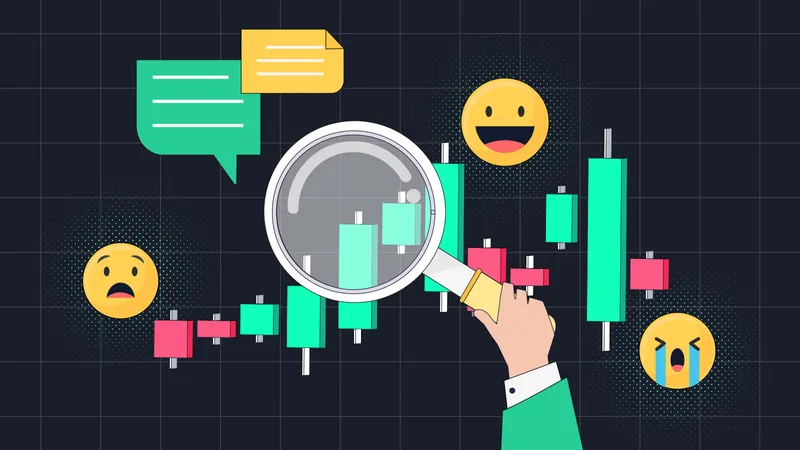Анализ рыночных настроений оценивает отношение, чувства, настроения и эмоции, связанные с финансовым активом. Он определяет, как другие трейдеры воспринимают рынок в целом или конкретный криптовалютный рынок. Понимание рыночных настроений в криптовалюте крайне важно, так как оно может существенно повлиять на цену любого цифрового актива.
В нашем руководстве по техническому анализу упоминалось, что ценовая динамика должна теоретически отражать всю доступную рыночную информацию. Однако на практике это не так. Это делает анализ рынка для криптотрейдеров сложной задачей.
Криптовалютный рынок отражает множество информации и спекуляций — каждый трейдер имеет свое мнение о том, почему рынок ведет себя определенным образом и стоит ли торговать в его направлении или против него. Анализ настроений становится полезным, так как помогает оценить преобладающее мнение, которое движет рынком.
Важно отметить, что, будучи розничным трейдером, ваше личное мнение не может повлиять на рынок. Анализ настроений помогает определить крупных игроков, контролирующих рынок, и оценить их рыночные позиции.
Что такое анализ настроений?
Анализ настроений учитывает эмоциональные мнения и отношение трейдеров к определенной криптовалюте. Он исследует психологию толпы, торгующей этим активом, в соответствии с их рыночными позициями. Анализ настроений в криптовалюте также отражает развитие криптовалюты, фиксируя социальные и торговые метрики.
В отличие от рынка Форекс и фондового рынка, криптовалютный рынок больше подвержен социальному давлению и может быть затронут одним твитом или обновлением дорожной карты. В общем, анализ рыночных настроений требует исследования отношения участников рынка, чтобы попытаться предсказать движения цен. Он также помогает понять общую динамику актива и хайп или страх, связанный с конкретной криптовалютой.
Как уже упоминалось, криптовалютный рынок имеет социальную природу, что означает, что если больше людей реагируют на какое-либо событие, мысль, чувство или идею, они могут значительно повлиять на импульс цен. Яркий пример такого сценария — когда один твит Илона Маска вызывает рост или падение цены Dogecoin.
Значение анализа рыночных настроений
Многие торговые стратегии сильно зависят от анализа настроений. Однако принимать решения стоит, основываясь на совокупности всей доступной информации, как это делается при фундаментальном анализе или техническом анализе. Например, анализ рыночных настроений может помочь определить, является ли FOMO оправданным или же это просто следование менталитету толпы.
Когда вы совмещаете технический и фундаментальный анализ с анализом настроений, вы можете:
- Улучшить понимание краткосрочной и среднесрочной динамики цен.
- Повысить контроль над своими эмоциями.
- Найти потенциально прибыльные возможности.
Как проводить анализ рыночных настроений в криптовалютах
Понимание рыночных настроений начинается с сбора мнений, идей и взглядов рынка. Хотя анализ настроений может быть полезным, не стоит полностью полагаться только на него. Вместо этого можно объединить полученную информацию с существующими знаниями и опытом, чтобы сделать обоснованные выводы.
Изучите релевантные страницы и каналы в социальных сетях, чтобы понять мнение сообщества и инвесторов по поводу определенного проекта. Общайтесь напрямую с командой проекта и членами сообщества через официальные форумы, серверы Discord или группы Telegram. Однако всегда следует быть осторожными и не основывать свое мнение только на одном источнике.
Использование социальных сетей — это лишь первый шаг. Существует множество методов, чтобы получить широкую картину рыночных настроений. Помимо мониторинга социальных каналов (особенно Twitter, который популярен среди криптоэнтузиастов), стоит рассмотреть следующие действия:
- Используйте инструменты для сбора данных, чтобы отслеживать социальные упоминания.
- Следите за последними новостями отрасли через медиа-порталы и блоги.
- Настройте оповещения или отслеживайте крупные транзакции, совершаемые "китами". Некоторые инвесторы регулярно следят за такими движениями, так как они могут повлиять на рыночные настроения. Бесплатные боты для отслеживания "китов" можно найти в Telegram и Twitter.
- Используйте CoinMarketCap для анализа индикаторов настроений рынка и сигналов ценообразования. Эти индексы обобщают данные из различных источников и кратко описывают текущие рыночные настроения.
- Используйте Google Trends для анализа уровня интереса к криптовалюте. Например, высокий уровень поисковых запросов "Как продать крипту" может указывать на негативные рыночные настроения.
Ниже приведены некоторые известные методы анализа настроений на криптовалютном рынке.
- Уровни финансирования (Funding Rates)
- Индекс настроений (Sentiment Index)
- Социальные сети
- Анализ сообществ
- Мониторинг "китов"
Уровни финансирования в криптовалютах
Уровни финансирования — это периодические выплаты трейдерам за длинные или короткие позиции в зависимости от разницы между рынками бессрочных контрактов и спотовыми ценами. Трейдеры либо выплачивают, либо получают финансирование в зависимости от открытых позиций.
Этот криптовалютный показатель можно отслеживать, и он коррелирует с рыночными настроениями, отображая периодические выплаты трейдерам на основе ценовых различий. Уровни финансирования предотвращают долгосрочное расхождение цен на обоих рынках и пересчитываются несколько раз в день.
Правило простое: если уровень финансирования положительный, рыночные настроения бычьи. Если же уровень падает, настроения становятся медвежьими.
Индекс настроений в криптовалютах
Индикатор настроений отражает восприятие рынка или экономики определенной группой людей. Эти индикаторы, основанные на психологии рынка, численно или графически оценивают настроения, чтобы спрогнозировать, как нынешние убеждения и позиции могут повлиять на будущую динамику рынка.
Индикаторы настроений, такие как индекс страха и жадности , оценивают, насколько оптимистично или пессимистично настроены участники рынка, и что они думают и чувствуют, чтобы спрогнозировать их дальнейшее поведение. Когда показатели настроений достигают аномально высоких или низких значений, они могут быть использованы как контртрендовые сигналы.
